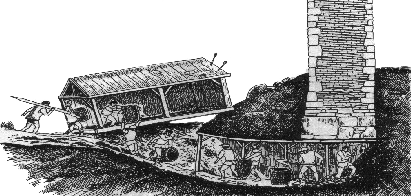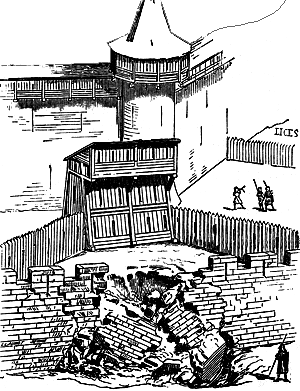A"mine" was a tunnel dug to destabilise and bring down castles and other fortifications. The technique could be used only when the fortification was not built on solid rock. It was developed as a response to stone built castles that could not be burned like earlier-style wooden forts.

![]() A
tunnel would be excavated under the outer defences either
to provide access into the fortification or more often to
collapse the walls. These tunnels were supported by temporary
wooden props as the digging progressed, just as in any mine.
Once the excavation was complete, the mine was filled with
combustible material. When lit it would burn away the props
leaving the structure above unsupported and liable to collapse.
A
tunnel would be excavated under the outer defences either
to provide access into the fortification or more often to
collapse the walls. These tunnels were supported by temporary
wooden props as the digging progressed, just as in any mine.
Once the excavation was complete, the mine was filled with
combustible material. When lit it would burn away the props
leaving the structure above unsupported and liable to collapse.
To save effort attackers would start the digging as near as possible to the wall or tower to be undermined. This exposed the sappers to enemy fire so it was necessary to provide some sort of defence. Pierre des Vaux de Cernay recounts that at the siege of Carcassonne in 1209, during the Cathar wars (Albigensian Crusade),







